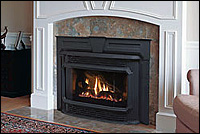Burn Green, Burn Smart

Advancements in hearth technology have produced a variety of green options that allow you to burn cleaner and more efficiently than ever before without sacrificing aesthetics. Thanks to ratings and regulations by organizations like EPA, LEED, NAHB and ENERGY STAR® you can confidently purchase fireplaces, stoves and inserts that are more responsible for providing safe indoor air quality while adding warmth to your home.
Here is some useful information to help you understand the different criteria to qualify as a "green" hearth product:
Leadership in Energy and Environmental Design (LEED)
Developed by the U.S. Green Building Council, the Leadership in Energy and Environmental Design (LEED) Green Building Rating System™ provides a third-party certification program for sustainable building. It is the nationally accepted benchmark for the design, construction and operation of high-performance green buildings.
- LEED has established a point system by which building design and construction can be rated to establish "best" practices.
- Fireplaces appear in the LEED system under the category of Indoor Environmental Quality (EQ).
- Fireplaces that conform to the requirements of this category would be considered to be contributing to the overall "green" rating of the home.
- Fireplaces are mentioned in section EQ 2-Combustion Venting.
- This section awards a maximum of two points to the builder of the home towards his overall rating for meeting the requirements of this section.
- The intent of this section is to "minimize the leakage of combustion gases into the occupied space of the home."
NAHB Green Building Guidelines
Developed by the National Association of Home Builders®, the NAHB Model Green Home Building Guidelines are designed to help systemize the green design and construction process for new homes. They provide a comprehensive resource for builders looking to implement green building practices. Debuting in 2005, these evolving and influential guidelines have helped bring more environmentally friendly building concepts into the mass market.
- Similar to LEED, the Green Building Guidelines use a point system to determine green best practices.
- There are three different levels of green building available to builders wishing to use these guidelines to rate their projects-Bronze, Silver, and Gold. At all levels, there is a minimum number of points required.
- Fireplaces are covered under Section 5.1.3 Minimize Potential Sources of Pollutants.
- The intent of this section is to "minimize the risk of smoke and combustion byproducts backdrafting into the home. Outdoor air is supplied directly to the combustion chamber so that indoor air is not required for combustion."
- Six points are allotted for hearth products that comply. These include direct-vent, sealed combustion gas fireplaces, sealed wood fireplaces or sealed wood stoves.
EPA Certification
The U.S. Environmental Protection Agency sets standards for air quality-including limits on the amount of particulate matter (microscopic particles) emitted by fireplaces and stoves. All wood stoves and fireplace inserts manufactured and sold today in the United States are required to be certified by the EPA.
- All stoves must prove emissions of less than 7.5 grams of particulates per hour (compared to the 42 grams of particulates per hour from wood burners manufactured in the 70s and 80s).
- All EPA-certified wood stoves and fireplace inserts have a permanent label on the back that bears the name of the United States Environmental Protection Agency.
- Not all areas comply with these regulations and may have restrictions on the types of hearth products allowed.
- In some areas, local jurisdictions have requirements about the types of fireplaces that can be installed.
- Pellet stoves and fireplace inserts are exempt from EPA certification.
ENERGY STAR® Indoor Air Package
Created by the Environmental Protection Agency, the ENERGY STAR® Indoor Air Package (IAP) helps builders meet an increasing demand for homes with improved indoor air quality and energy efficiency. These guidelines detail the EPA's stringent specifications and help progressive builders and homeowners construct ecologically conscious buildings and homes.
- ENERGY STAR Indoor Air Package guidelines were developed based on the best available science and information about risks associated with indoor air quality problems, and balanced with practical issues of cost, builder production process compatibility, and enforceability.
- Fireplaces appear in the IAP guidelines under the category of Combustion Appliances.
- Fireplaces are covered under Section 5.3 of the IAP Specification guidelines.
Smart Tips
- Keeping your chimney clean provides a good draft, reducing the likelihood for dangerous gases to build up inside the home during fireplace operation.
- Keeping the fireplace damper closed when the fireplace is not in use prevents up to 8% of heated air from going up the chimney.
- Properly dried hardwoods-hickory, oak, maple, or ash-are the most efficient fuel for a wood-burning stove or fireplace.
For more information about LEED, NAHB Green Home Building Guidelines, EPA or ENERGY STAR® Indoor Air Package, please reference:
http://www.greenhomeguide.org/green_home_programs/LEED_for_homes.html
http://www.nahbgreen.org/Guidelines/nahbguidelines.aspx
http://www.epa.gov/
http://www.energystar.gov/



.png)
.png)

 Advancements in hearth technology have produced a variety of green options that allow you to burn cleaner and more efficiently than ever before without sacrificing aesthetics. Thanks to ratings and regulations by organizations like EPA, LEED, NAHB and ENERGY STAR® you can confidently purchase fireplaces, stoves and inserts that are more responsible for providing safe indoor air quality while adding warmth to your home.
Advancements in hearth technology have produced a variety of green options that allow you to burn cleaner and more efficiently than ever before without sacrificing aesthetics. Thanks to ratings and regulations by organizations like EPA, LEED, NAHB and ENERGY STAR® you can confidently purchase fireplaces, stoves and inserts that are more responsible for providing safe indoor air quality while adding warmth to your home.

